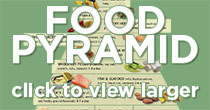Reintegrating the Basics of Food as Medicine
 by Vanessa Proznick-Fransoo by Vanessa Proznick-Fransoo
The topic of food as medicine is becoming increasingly important in our society as we are seeing the negative impact of inflammatory diseases on individual health and increasing cost to the health-care system. “Seventy-five per cent of health-care costs go to treating chronic diseases that are largely preventable” (Escape Fire). The allopathic model of care is a “find-it-and-fix-it” approach to health, primarily focused on disease treatment and management. We need to change our mentality of health by promoting self-care behaviours that will empower people to take control of their health and decrease their risk of chronic disease. Integrating nutrition through an anti-inflammatory diet and a mindful approach to food choices is one key element to reducing systemic inflammation, along with exercise and stress reduction practices.
The anti-inflammatory diet (AI) is a lifestyle approach to nutrition, representative of food patterns in the olive-growing regions of Greece and Italy where good health and longevity were associated with significantly lowers levels of heart disease, certain cancers, and other diet-related chronic disease (Willet, Sacks, Trichopoulou, Drescher, Ferro-Luzzi, Helsing, 1995, p. 1402s). People indigenous to these areas had traditional patterns of eating which consisted of foods that were primarily plant based and the primary source of fat came from consumption of olive oil. Dairy, eggs, and red meats were limited. Fish and poultry were consumed in moderation as was red wine.
The AI diet, depicted by a pyramid, was developed by Dr. Andrew Weil and is a guideline to reducing inflammation. The base level represents the largest intake of food while the top represents those foods that should be eaten occasionally.
Vegetables and Fruits—Base Level
• Consuming a rainbow of colours in vegetables and fruits provides numerous phytochemicals having anti-oxidant and anti-inflammatory effects such as antibiotic, antiallergic, antidiarrheal, and antiulcer (Khalsa, 2014).
• Buying organic and local whenever possible limits the amount of pesticides a person consumes, which has its own inflammatory effects. A good reference provided by the Environmental Working Group is the Dirty Dozen List and Clean 15 which provides a listing of the top 12 most contaminated and 15 least contaminated vegetables and fruits.
Whole and Cracked Grains, Pasta, Beans, and Legumes
• Eat whole and cracked grains and cook pasta to al dente; a firmer texture takes the body longer to break foods down into sugars, thus avoiding spikes in blood sugar levels that cause rapid increases in insulin—another inflammatory response.
• Avoid processed flours and sugars. Fructose specifically eaten in large quantities increases blood pressure, plays a role in kidney disease, and consumption of high fructose corn syrups (HFCS) causes damage to the liver (Lim, 2010). HFCS should be avoided whenever possible, however it is increasingly found in many processed foods such as breakfast cereals, fruit drinks, nutrition and energy bars, agave syrup, and yogurt. Many of these we associate with better nutrition choices.
• Increasing fibre through consumption of berries, beans, oats, barley, flaxseed, and legumes provides cardio-protective mechanisms through lowering of triglycerides.
Fats
• Consume healthy fats in the form of extra virgin olive oils, expeller-pressed canola oil (non-GMO), nuts, avocados, and seeds. We need to remember that fats are essential to the diet; however, it is the amount and type of fat that influences inflammation. Monounsaturated fats and polyunsaturated fats are a better alternative to saturated fats or trans-fats found in hydrogenated and partially hydrogenated oils (Khalsa, 2014).
• Egg yolks should be limited due to their high cholesterol content which contributes to plaque formation in arteries.
Fish and Seafood
• Consume fish oil supplements or oily fish such as sardines, herring, black cod, and wild salmon in moderation. Farmed fish are inflammatory due to the nature of the food they are fed, which is often vegetable based such as corn and corn products. In addition, one needs to be aware of the environment that surrounds the farming activity such as chemical run-off from nearby fields and consideration of treatment with antibiotics. (Rejuvenation Science).
Whole Soy foods
• Consuming edamame, tofu, and tempeh, provide plant-based protein. The compounds contained in soy contribute to lower incidences of coronary heart disease, atherosclerosis, type 2 diabetes, and decrease risk of certain cancers (Xiao, 2008, p. 1244S).
• When purchasing soy products, things to consider are the source; whether it is a genetically-modified organism (GMO) and what the processing procedures are, as it has an impact on nutritional components affecting quality of the product.
Mushrooms
• Cooked Asian mushrooms such as shiitake, enoki, and maitake have potent antioxidant, anti-inflammatory, anticarcinogenic, and anti-hypertensive effects (Guillamon, 2010).
Other Protein Sources
• Natural cheeses, low-fat dairy, omega-3 enriched eggs, poultry, and lean meat consumption is minimal. Consider buying organic dairy or meat when possible. Grass-fed cattle have a more desirable fatty acid profile, “higher in precursors for vitamin A and E and cancer-fighting antioxidants …compared to grain-fed contemporaries” (Daley, Doyle, Nader & Larson, 2010).
Lastly, the upper 3 to 4 layers of the AI pyramid represent those of the “super foods” possessing powerful antioxidant/anti-inflammatory effects. These include herbs and spices such as garlic, turmeric and cinnamon, green tea, purple grape juice, and red wine in moderation. Fruits such as blueberries, grapes, bilberries, and cranberries, as well as dark chocolate (> 70% cocoa) have also been linked to heart health (Khalsa, 2014).
References: Available upon request.
Vanessa Proznick-Fransoo is a Registered Nurse working in Saskatoon. She has completed studies in Integrative Health through the Arizona Center for Integrative Medicine (www.integrativemedicine.arizona.edu) with a focus on disease prevention through various health-promoting activities encompassing body, mind, and spirit. Her further studies are focused on Health Coaching, also out of Arizona with a mission to assist individuals toward a road to wellness and creating a movement in prevention of chronic disease. She can be reached at proznickfransoo@sasktel.net. A good resource for further information is www.drweil.com. |
